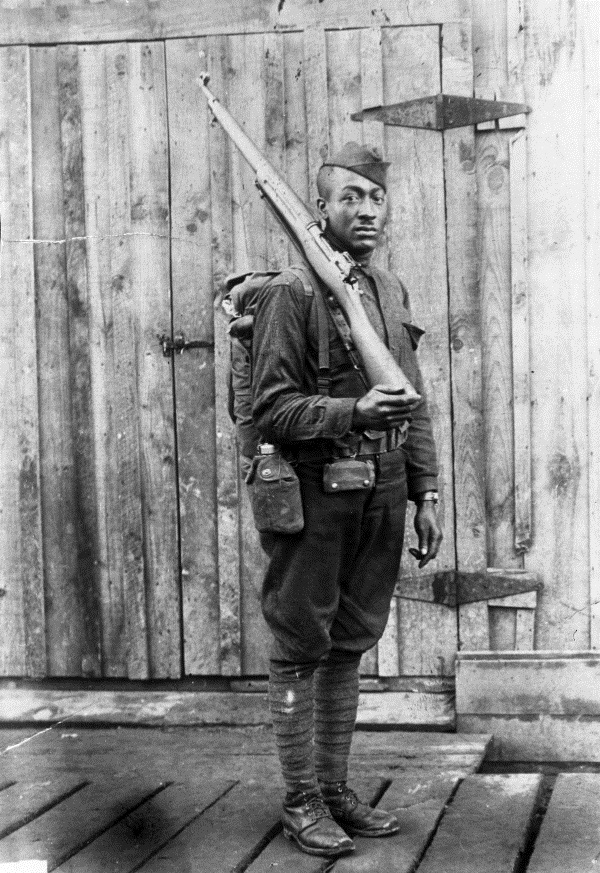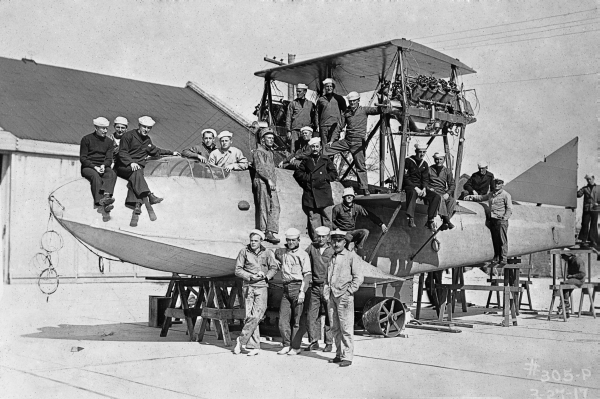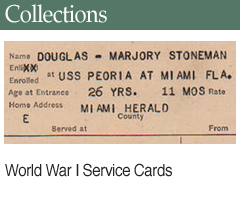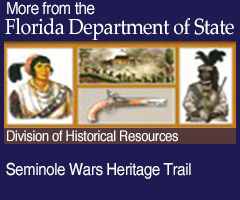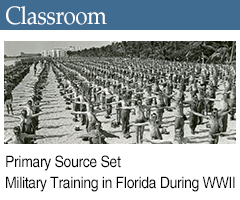Guide to Military Records and the Wartime Experience
at the State Archives of Florida
The Mexican Punitive Expedition, 1916-1917 & World War I, 1914-1918
Contents
Prior to the United States' involvement in the First World War, it conducted a short-lived and unsuccessful military operation against the paramilitary forces of Francisco "Pancho" Villa, a Mexican revolutionary, from March 14, 1916, to February 7, 1917. Incensed by Villa's attack on the border town of Columbus, New Mexico, an expeditionary force attempted to pursue and capture Villa while another 140,000 troops patrolled the U.S.-Mexican border. This included more than 1,000 men of the 2nd Florida Infantry Regiment led by Colonel Albert H. Blanding of Bartow.
Floridians at the border saw little action, and as the U.S. intrusion into Mexico caused increasing resentment with no success against Villa, President Woodrow Wilson quietly ordered the troops to withdraw. The men returned home just in time for a brief respite before a much larger and more demanding conflict.
When the United States entered World War I on April 6, 1917, thousands of Floridians joined the millions of other Americans heeding President Woodrow Wilson's call to make the world "safe for democracy." Although the United States was involved in the global conflict for only 19 months, the war still impacted the social, economic and environmental conditions of Florida. Of the 4 million American men and women who joined the armed services between 1917 and 1918, more than 42,000 were Floridians, serving in the Army, Marine Corps, Navy and Coast Guard.
On the home front, countless others performed their patriotic duty by purchasing liberty bonds, volunteering with service organizations, and conserving food and raw materials. These efforts occurred against the backdrop of the war's larger domestic side effects. A series of deadly influenza outbreaks in 1918, heightened racial tensions, intense anti-German sentiment, and the increased political activism of woman suffragists and Black Americans further consumed the attention of Florida's civilian patriots.
After the November 1918 armistice, Florida's veterans returned to the familiar comforts of home. While much of the state remained the same as it had been before the war — mostly rural with an agricultural economy — WWI undoubtedly marked Florida's transition into a new era rife with modern industrial, political and economic possibilities.
The State Archives has a variety of records that document Florida's involvement in the Mexican Punitive Expedition and the First World War, as well as the experiences of Florida's citizens at the time. The records include traditional military records such as draft records and rosters as well as maps, diaries, letters and other personal papers.
Government Records
S1142
Florida. Office of the Adjutant General
World War I Induction Records of Floridians, 1917-1918
6.5 cubic feet
The series contains lists of men called into service during World War I. The records generally include the applicant’s race, his address and the date of his induction. Some lists include the occupations of the inductees and information on whether the individual entered military service.
S1204
Florida. Military Department
World War I Army Card Roster, 1924
8 cubic feet, 11 microfilm reels
This series consists of a card roster of Floridians who served in the U.S. Army during World War I. Each soldier has one or two cards that provide information on his military service, such as name, serial number, residence, place and date of birth, military organizations in which he served, rank, engagements in which he participated, wounds or injuries received, dates serving overseas, discharge date, percentage disabled and additional remarks. On the microfilm copy, Black veterans are listed separately from white veterans; officers are listed on Roll 11. Roll 10 contains the cards for promotion or reenlistment.
S1233
Florida. Military Department
World War I Coast Guard Card Roster of Floridians, 1925
.25 cubic foot, 1 microfilm reel
The series contains a card roster of Floridians who served in the U.S. Coast Guard during World War I. The cards generally include the serviceman's full name, date and place of enlistment, age and address at time of enlistment, place or ship in which he served, rating or assignment while on active duty, and date and place of discharge.
S1234
Florida. Military Department
World War I Marine Corps Card Roster of Floridians, 1925
.50 cubic foot, 1 microfilm reel
The series contains a card roster of Floridians who served in the U.S. Marine Corps during World War I. The cards generally include the serviceman's full name, residence, place and date of birth, place and date of enlistment, organization in which he served, promotions, engagements participated in (if any), wounds (if any), date of discharge and additional remarks.
S1249
Florida. Military Department
World War I Navy Card Roster of Floridians, 1925
2.5 cubic feet, 4 microfilm reels
This series contains a card roster of Floridians who served in the U.S. Navy during World War I. The information includes name, rank or rating, location and/or ships served, date and place of discharge and additional remarks.
S1296
Florida. Office of Secretary of State
Record of Commissions for County Guards, 1917-1920
1 volume, .75 cubic foot
The Florida Legislature created the County Guards in 1917 to replace the National Guard of Florida that it had activated for European service as part of the American Expeditionary Force of World War I (Chapter 7292, Laws of Florida). Each county was responsible for nominating officers and bore the costs of equipping the Guards. The County Guards were to be available for service in times of riot or disorder. The Legislature abolished the County Guards four months after the end of World War I. The series contains records of commissions for the County Guards. A bound volume contains the official commissions signed by the Governor and the Secretary of State. The volume contains an alphabetical index of counties. Also included are resignation letters submitted and notifications of appointments from 1917 to 1918. Although the County Guards disbanded four months after a peace treaty was concluded, a few commissions are dated in 1919 and 1920.
S1333
United States. Army. Florida 2nd Infantry Regiment
Journal, 1916-1917
.25 cubic foot
The 2nd Florida Infantry Regiment was a Federalized National Guard unit that mobilized in July 1916 and mustered out in March 1917. It served as a border guard during the punitive expedition into Mexico in pursuit of Mexican cross border raiders. This journal contains the daily unit activities of the 2nd Florida Infantry Regiment, its battalions and companies while serving during the Mexican Punitive Expedition. Only a few of the regiment's members are named in the entries.
S1344
Florida. Military Department
Summary of Florida Veterans of World War I, 1925
3 volumes
This series contains a summary of the citizens of Florida who served in the armed forces of the United States during World War I. It documents the individual’s name, race, period served, the branch in which he served, ranks attained, those killed or wounded, and any awards or citations earned. The first volume contains both state and county statistical summaries of how many officers and enlisted served in the Army, Navy or Marine Corps, and the number of dead and wounded or deserted. The Army statistics list Black and white servicemen separately. The Marine Corps and Navy did not commission or enlist non-whites at the time. The listings for the counties include name, race, rank if an officer, branch of service, place of residence and period of service.
S1416
United States Army. Florida 2nd Infantry Regiment
Regimental Roster While on Federal Service, 1916-1917
.25 cubic foot
The 2nd Florida Infantry Regiment was a Federalized National Guard unit that mobilized in July 1916 and mustered out in March 1917. It served as a border guard during the punitive expedition into Mexico in pursuit of Mexican cross border raiders. This series is a listing of the units, names, ranks, home stations and dates of service of the members of the 2nd Florida Infantry Regiment during its service on the border with Mexico.
S1418
United States Army. 4th Corps Area Headquarters
Lists of Florida Draft Evaders in World War I, 1920-1922
.25 cubic foot
The local draft boards that administered the conscription of men in the United States for service during the First World War reported to U.S. Army Corps Area Commands; boards in the Southeast reported to the 4th Corps Area and provided Command with the names and hometowns of men who were inducted, rejected or had failed to respond to orders to report for induction. The Corps headquarters then published the names of those evading conscription to identify those men who were in violation of the draft laws so that they could be apprehended and prosecuted. This series contains lists of those men whom the Army reported as draft "deserters" during World War I. These names were to be published in newspapers or posted in public places. The lists also contained the citations of law or regulations under which law enforcement could seize the evaders.
S1461
Florida. Military Department
Applications for Victory Medal, 1921
.50 cubic foot
This series contains applications for the Victory Medal that Florida’s World War I veterans sent to the U.S. Office of the Adjutant General. The applications generally include the applicant's full name, army serial number, rank, company name, local address, participation in any major battles, defensive sector service with dates and areas served overseas. Also recorded on the applications are approval or denial for a Victory Medal and which, if any, battle clasps were issued.
S1848
National Archives
World War I Draft Registration Cards (Florida), 1917-1919
39 microfilm reels
The Selective Service Act of 1917 authorized the president to temporarily increase the military establishment of the United States and to draft men for induction into military service. This microfilm publication contains World War I draft registration cards for Florida. The information on each registration card may differ somewhat but the cards usually include name, permanent home address, age, date and place of birth, race, citizenship, civilian occupation, place of employment, nearest relative and the registrant's signature. The physical description includes height, build, color of eyes and color of hair. It is important to note that not every man who registered for the draft served in the military and not all men who served in the military registered for the draft. Furthermore, these are not military service records; the draft record ends when an individual reported to military training camp. These records contain no information about an individual's military service.
In addition to the series listed above, the State Archives also has microfilmed copies of military discharge records for soldiers and sailors who served in World War I. These records, dating from 1917 to 1950, originate from the following counties: Baker, Bay, Bradford, Brevard, Calhoun, Citrus, Clay, Dade, DeSoto, Escambia, Franklin, Gadsden, Gilchrist, Hamilton, Hernando, Hillsborough, Holmes, Jackson, Jefferson, Lake, Leon, Levy, Madison, Manatee, Okeechobee, Orange, Pasco, St. Johns, Santa Rosa, Sumter, Suwannee, Taylor, Union, Wakulla and Walton. These materials are copies of records maintained at the Clerk of the Circuit Court in each county.
Personal and Family Papers
M82-8
Drew Family Papers, 1856-1999
32.25 cubic feet
George Franklin Drew was a successful businessman in the lumber industry before he became Florida's 12th governor in 1876. Two of Governor Drew's grandsons, Herbert J. Drew and George F. Drew, served overseas during World War I as officers in the American Expeditionary Force. Of interest within these records is correspondence, military records, personal papers and other materials related to the family’s experience during World War I.
M82-82
R. E. MacDonald, U.S.S. Florida Photographic Postcards, 1915-1917
9 postcards
The U.S.S. Florida (BB-30) was a U.S. naval battleship that served during World War I in the North Sea. When the U.S. entered the war in 1917, the battleship left the Virginia Coast as part of Battleship Division Nine to join the British Grand Fleet in the North Sea. R.E. MacDonald was a naval officer on the U.S.S. Florida while it served with the Grand Fleet. This collection consists of nine photographic postcards of the naval battleship during the First World War. The images depict the ship at sea, sailors loading the ship's guns, the ship firing, and several images of the ship's deck.
M87-46
Albert Hazan Blanding Papers, 1917-1958
.5 cubic foot
Albert Hazen Blanding was a prominent National Guard officer. He graduated from East Florida Seminary in Gainesville in 1894. In 1895 he enrolled in the Gainesville Guards, Florida State Troops. By 1899, he was a Colonel in the 2nd Florida Infantry Regiment, and he commanded the Regiment when it was called into federal service during the Mexican Punitive Expedition from 1916 to 1917. During World War I, Blanding served in France with several units and earned the Distinguished Service Medal. This collection contains Blanding’s papers, including photocopies of three pocket diaries he kept during his service in World War I that document the participation of American troops in World War I.
M88-29
Joseph P. Butzloff Oral History and Photographs, 1988
5 items
Joseph P. Butzloff was born in Brunswick, Georgia, on April 5, 1896. After moving to Florida, he enlisted in Company H, 2nd Infantry, Florida National Guard in September 1914. During the Mexican Punitive Expedition, Butzloff served with his unit along the Texas-Mexican Border. During the First World War he served in France with the 116th Machine Gun Battalion. This collection consists of Butzloff’s oral history in which he details his participation in the Mexican Punitive Expedition and World War I. No transcription of the interview is available. Also included in the collection are copies of four photographs of Mr. Butzloff; two were taken during World War I, one during the final reunion of Company H, 2nd Florida Infantry in 1981, and one in 1988.
M89-33
World War I Poster, 1917
This collection consists of one World War I poster with the heading, "World War for Liberty, United States Army, 1st Infantry (Florida), Company M." The poster contains a roster of the company's officers and enlisted members, as well as a list of field grade officers. The poster includes a picture of Woodrow Wilson, the flags of the United States and the Allied Powers, and depictions of the various branches of the Army and Navy.
M90-24
W. George McMullen Memoirs, 1985
1 folder
W. George McMullen, born in Largo, Florida, enlisted in the Army in 1917 and served with the 9th Infantry Regiment of the 2nd Division, American Expeditionary Force. The units of the 2nd Division were among the first United States forces in France to meet the Germans in battle. McMullen was present for much of the early fighting. This collection contains McMullen’s memoirs of his participation in World War I. His recollections deal with the who, what, where and when of his military life, and express the realities of army life both in the United States and in Europe.
M99-1
Diaries of William Terrell Eddins, 1901, 1908-1915, 1937-1942
.5 cubic foot
William Terrell Eddins moved with his family from Mississippi to Florida in 1894 or 1895. He served briefly in the Army during World War I, sometime between 1918 and 1919. This collection consists primarily of Eddins’ personal pocket diaries including one volume that consists of brief notes concerning his experiences and acquaintances during his service in Europe.
N2001-2
Bevins Family Papers, 1900-1936, 1936, 1999
.5 cubic foot
This collection contains correspondence, photographs and some newspaper clippings that pertain to the Bevins family of Davenport, Florida. The Bevins family moved to Davenport prior to 1915 from Pennsylvania and attempted to homestead. After the U.S. entered the First World War, Algy and his brother Arthur enlisted into the U.S. Coast Guard and served aboard the U.S.S. Tampa, a Coast Guard cutter serving on convoy duty with the U.S. Navy in Europe when it disappeared into a fog bank and exploded with the loss of all hands after a German U-boat torpedoed it. Included in the collection is a letter from the Navy to the parents of Algy and Arthur describing the work done by their ship and the circumstances surrounding their loss. The clippings are newspaper accounts of the sinking and the various memorial services held in commemoration of their sacrifice. The photographs are of Algy in civilian and naval pursuits, Arthur aboard the Tampa, and some other views of life in Florida and England.
N2008-9
Kirvin Family Papers, 1891-1918
.5 cubic foot
In 1891, Mary Ann Kirvin married Joseph Wildon Whitfield in Calhoun County, Florida, and they had three children: Allie, Minnie, and Joseph Alfred. When Mary Ann died around 1898, the three children went to live with their grandmother Mary Ann Stone Kirvin in Allanton, Florida. During World War I, Joseph Alfred Whitfield served as a captain and saw action in France. This collection consists of Mary Ann Stone Kirvin’s personal papers that document Kirvin family affairs, primarily through family correspondence and tax records. The correspondence includes several letters from Joseph Alfred during his military training and deployment in World War I.
N2018-1
Manley Pollock Papers, 1915-1919
.5 cubic foot
Manley Pollock, born in Wisconsin, enlisted in the U.S. Army in 1918. He served as a private at the Dorr Field Flying School Detachment Air Service from April 22 to November 15, 1918. Located east of Arcadia, Florida, Dorr Field was established during World War I to support flight training operations at Carlstrom Field. This collection documents Manley Pollock's service in the Army, specifically his time stationed at Dorr Field during World War I. The collection consists of a scrapbook, postcards, a panoramic photograph of the Dorr Field Flying School Detachment Air Service, and Pollock's military records and medals.

 Listen: The Blues Program
Listen: The Blues Program